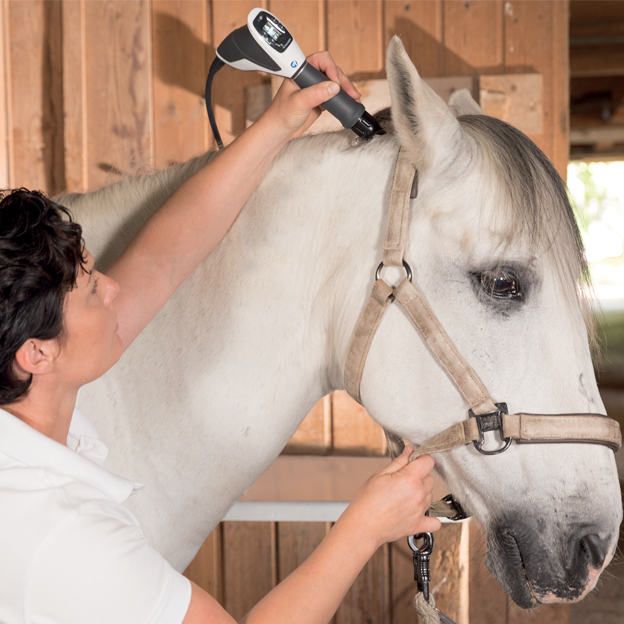How Laser Treatment in Horse Treatment Is Transforming Veterinary Look After Horses
Laser therapy has arised as a transformative technique in equine veterinary treatment, providing a non-invasive remedy that expedites recovery and improves overall health. The portability and versatility of laser therapy devices additionally highlight their growing indispensability among vets.
Comprehending Laser Treatment

The technology behind laser treatment is based in the principle of photochemistry, where photons are absorbed by chromophores within cells, causing increased ATP production and inflection of responsive oxygen species (Equine Therapy). This, subsequently, advertises cellular spreading, minimizes inflammation, and increases healing. Vet practitioners make use of different kinds of lasers, including low-level lasers (LLLT) and high-power Class IV lasers, relying on the particular therapeutic objectives and the nature of the equine problem being treated
Different laser wavelengths and power settings are meticulously picked to target numerous tissue midsts and accomplish desired scientific results. Safety methods are vital, as improper use can bring about thermal damages or suboptimal restorative effects. Thus, a thorough understanding of laser therapy's mechanisms and applications is vital for its effective application in equine vet method.
Benefits for Equine Health
The myriad benefits of laser treatment for equine health and wellness encompass enhanced healing, pain reduction, and enhanced movement. This innovative treatment modality leverages certain wavelengths of light to permeate tissues, promoting mobile feature and advertising fast tissue fixing. The non-invasive nature of laser therapy makes sure marginal stress and anxiety and pain for the equine, facilitating a smoother recuperation procedure.
Boosted healing is one of the leading advantages, as laser treatment increases cellular regrowth and collagen synthesis. Pain decrease is accomplished via the anti-inflammatory impacts of laser therapy, which lowers swelling and reduces the manufacturing of pain-inducing chemicals.
Improved flexibility is an additional critical benefit, particularly for efficiency and working horses. By minimizing inflammation and pain, and boosting tissue repair work, laser therapy assists in recovering joint feature and muscular tissue adaptability. The advancing impact of these benefits is not just a quicker return to regular activity yet likewise a total enhancement in the equine's high quality of life. Hence, laser therapy stands as a transformative tool in modern equine veterinary care.
Common Problems Dealt With
Laser treatment has actually emerged as a functional therapy choice for a range of usual equine problems. In addition, laser therapy is reliable for problems like osteoarthritis, where it helps alleviate joint swelling and promote tissue repair work.
Wound administration is one more area where laser treatment has revealed significant assurance. Persistent injuries or slow-healing ulcers can be specifically difficult in horses, but laser therapy boosts cellular regrowth and improves blood circulation, therefore accelerating the recovery procedure. In addition, laser therapies have been efficiently utilized in managing unguis conditions such as laminitis and abscesses, reducing discomfort and promoting quicker recuperation.

Innovation Behind Laser Therapy
Past the myriad problems treatable with laser treatment, the innovation itself values closer assessment. At the heart of laser therapy is using certain wavelengths of light to permeate cells and evoke biological responses. These wavelengths, commonly varying from 600 to 1000 nanometers, are selectively soaked up by chromophores in the skin, muscle, and various other cells, initiating a waterfall of cellular events.
Laser tools used in vet medication frequently use low-level laser therapy (LLLT) or cool laser treatment. Unlike high-powered medical lasers, these tools operate at reduced power levels, enhancing restorative benefits while minimizing thermal damage. The power from the laser light promotes adenosine triphosphate (ATP) production, improves mobile metabolic rate, and speeds up tissue repair processes.

Success Stories and Study

Showcasing the substantial advantages of laser treatment, countless success stories and study brighten its transformative effect on equine health. One such situation involves a pedigreed racehorse struggling with chronic tendonitis. Conventional therapies yielded marginal improvement, however after integrating laser therapy right into the program, the equine showed substantial decreases in swelling and discomfort within weeks, inevitably returning to competitive racing.
One more compelling example features a dressage horse identified you could look here with extreme neck and back pain, restricting its performance. A vet group employed low-level laser treatment (LLLT) to target the inflamed locations, leading to significant improvement in adaptability and a noteworthy decline in pain. Over numerous sessions, the steed restored its peak form, showcasing the efficiency of laser treatment in attending to bone and joint concerns.
Additionally, a study carried out at a leading equine center analyzed 50 steeds with numerous soft cells injuries treated with laser treatment. The results stood out: 85% of the equines demonstrated sped up healing times and enhanced wheelchair. These instances underscore the adaptability and efficiency of laser treatment in equine medicine, providing a non-invasive, scientifically-backed technique to improving recuperation and performance in equines.
Conclusion
Laser therapy is changing equine veterinary care by supplying a non-invasive treatment that accelerates healing, minimizes swelling, and minimizes discomfort. With its effectiveness in dealing with a variety of problems, from bone and joint injuries to persistent ailments like osteo arthritis, this technology significantly enhances equine wellness and movement. The transportability and versatility of laser therapy additionally underscore its transformative influence on veterinary methods, strengthening its role as an important tool in contemporary equine medical care.